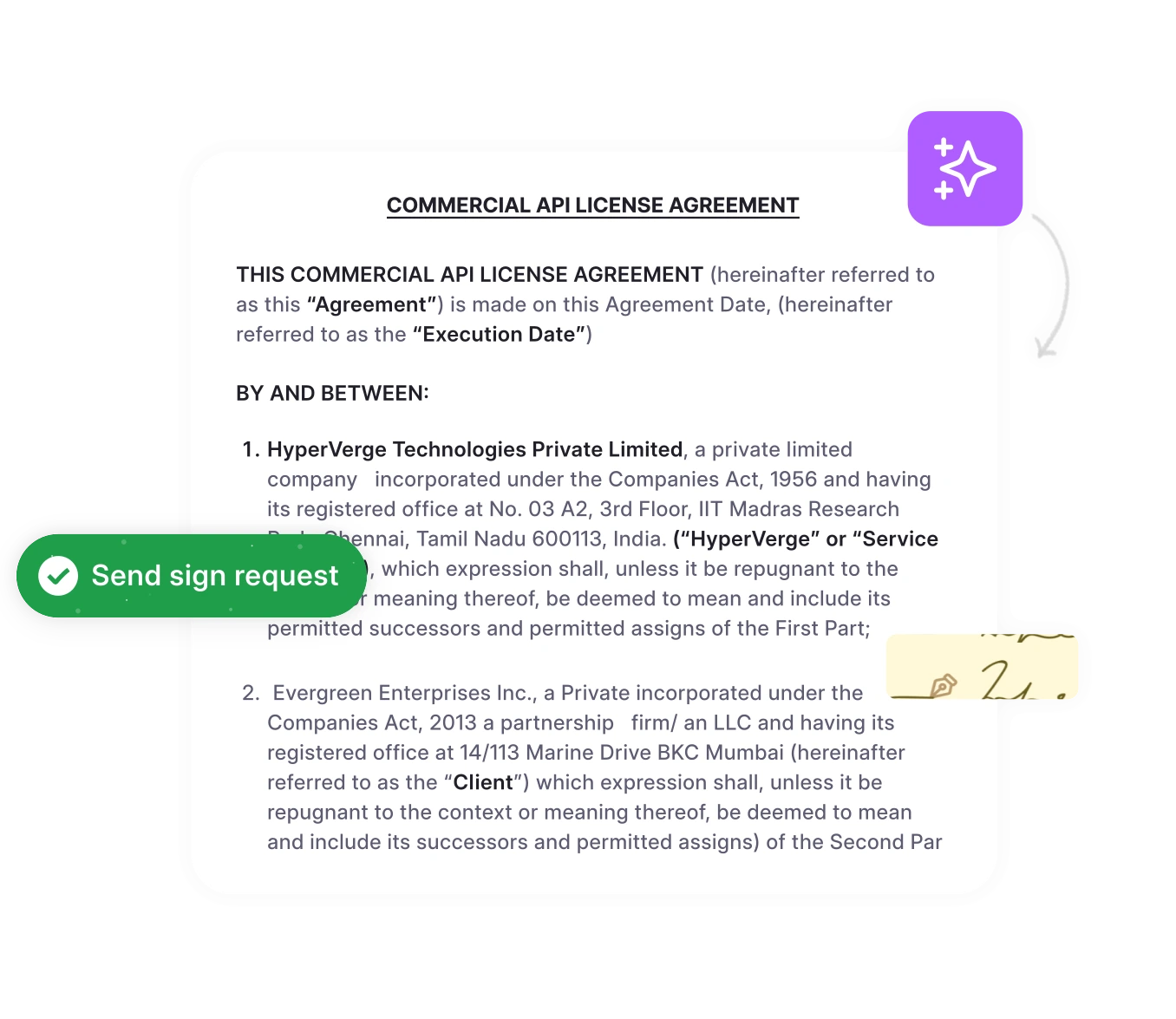Most contract disputes stem from unclear performance expectations. Set measurable deliverables and objective success criteria so well-intentioned agreements do not devolve into “he said, she said” conflicts.
A performance contract eliminates this ambiguity by defining exactly what success looks like before work begins. Modern contract management software features now make it possible to track these performance metrics automatically, giving legal teams real-time visibility into milestone completion and deliverable status.
This guide covers everything you need to create, implement, monitor, and drive accountability and performance between stakeholders.
What is a performance contract?
A performance contract is a formal agreement that outlines specific deliverables, quality standards, and expected outcomes between parties. According to the National Institute of Governmental Purchasing, performance-based contracts describe requirements in terms of results rather than how work is accomplished, setting measurable standards and using incentives appropriately.
The performance of contract execution focuses on achieving defined objectives, not following prescribed methods. This results-oriented approach shifts risk and responsibility to contractors while rewarding exceptional performance. Whether in business partnerships, government agencies, or project-based work, these agreements help ensure everyone understands what constitutes success and how it will be measured.
What are the different types of performance contracts?
Different situations call for different approaches to performance contracting. Understanding each type helps you structure agreements that align with your specific business needs and industry context.
Output-based contracts
Output-based contracts focus on specific deliverables rather than how work gets done. The contractor has complete flexibility in their approach as long as they meet defined outputs. Success is measured by tangible results, not hours worked.
Industry examples: Software development projects, consulting engagements, content creation, product manufacturing
Service level agreements (SLAs)
SLAs define minimum service standards for ongoing relationships, often with penalties for failing to meet established thresholds. These performance contracts work best when services need consistent quality over extended periods.
Industry examples: IT services, cloud providers, customer support operations, managed services
Energy Savings Performance Contracts (ESPCs)
ESPCs are specialized performance contracts common in facility management where contractors guarantee energy savings that offset the cost of efficiency upgrades. The energy performance contract model ensures clients only pay when savings materialize.
Industry examples: Government buildings, educational facilities, healthcare systems, commercial real estate
Public-private partnerships
These complex arrangements use performance contracts to ensure private entities deliver public services effectively. Contract performance measures focus on service quality, accessibility, and cost efficiency for taxpayers.
Industry examples: Infrastructure projects, transportation systems, public utilities, healthcare services
Arts and live performance contracts
Performance contracts in entertainment define specific terms for live events, including date, time, location, technical requirements, and cancellation procedures. These protect both performers and venues while clarifying expectations.
Industry examples: Concert venues, theater productions, corporate events, festivals
Performance-based contracting lets contractors be experts in technical delivery, focusing on desired results, not how the work is done, giving them flexibility.
–TechFAR Hub
Performance contract vs. regular contract
Before moving forward, let’s clarify a common confusion. Understanding the fundamental difference between performance contracts and regular contracts helps you choose the right approach for your situation. Modern digital contract management systems help organizations implement the appropriate contract type for each scenario.
| Aspect | Performance Contract | Regular Contract |
| Primary Focus | Results and deliverables | Methods and processes |
| Contractor Flexibility | High – determines own approach | Low – prescribed steps to follow |
| Payment Structure | Milestone or outcome-based | Fixed fee or hourly rate |
| Accountability Basis | Tied to deliverable completion | Tied to effort and time spent |
| Performance Measurement | Contract management performance metrics and KPIs | Hours worked, tasks completed |
| Best Used For | Project-based work, consulting, specialized services | Ongoing employment, routine services, standard operations |
With this distinction clear, you can structure agreements that drive the contract performance outcomes your organization needs.
How to create a performance contract?
Creating an effective performance contract requires following a structured contract performance management process. This contract performance management framework ensures your agreement is comprehensive, enforceable, and aligned with business objectives.
Step 1: Identify and define the parties involved
Clearly identify all contracting parties, whether individuals, companies, or government entities. Define roles, responsibilities, and authority levels for each party to prevent confusion about who does what throughout the contract term.
Specify decision-makers and points of contact. Include organizational affiliations and signing authority to ensure agreements are legally binding. Clarity at this stage prevents disputes about representation and accountability later.
Step 2: Establish clear objectives and deliverables
Use the SMART framework (Specific, Measurable, Achievable, Relevant, Time-bound) to define objectives. Specify concrete deliverables instead of vague activities. For example, “increase qualified leads by 25% within 6 months” works far better than “provide marketing services.”
Align objectives with broader organizational goals. What is a performance obligation in this context? It’s the specific outcome or deliverable that the contractor must achieve to fulfill the agreement. Use contract authoring tools with AI-powered templates to draft SMART objectives that automatically populate standard clauses while allowing customization for specific deliverables.
Step 3: Define performance standards and KPIs
Establish concrete contract management key performance indicators that objectively evaluate success. The World Bank emphasizes that KPIs serve as critical measures to monitor performance and ensure deliverables are met.
Contract management performance metrics might include:
- Response times (Example: 24-hour acknowledgment of issues)
- Quality scores (Example: 95% defect-free delivery rate)
- Production targets (Example: 1,000 units per month)
- Customer satisfaction scores (Example: 4.5/5.0 average rating)
Create tiered contract performance measures:
- Minimum acceptable: Baseline requirements that must be met
- Target performance: Expected standard for successful completion
- Stretch goals: Exceptional performance worthy of bonuses
Contract performance metrics examples should be realistic, verifiable, and mutually agreed upon by all stakeholders before work begins.
Step 4: Set the timeframe and milestones
Specify contract start and end dates clearly. Define key milestones throughout the project lifecycle with specific deadlines. Breaking long projects into phases with checkpoints makes monitoring contract performance more manageable.
Include provisions for extensions if certain conditions are met, such as force majeure events or client-requested scope changes. Document how timeline adjustments will be handled to prevent disputes.
Step 5: Outline payment terms and incentives
Define the compensation structure, whether fixed fee, performance-based payments, or a combination. Link payments to milestone completion to align incentives with deliverables. Value-based contract performance structures ensure contractors benefit when clients achieve desired outcomes.
Include incentive structures that motivate exceptional work: “10% bonus for exceeding target by 15% or more.” Specify invoicing procedures, payment due dates, and any penalties for underperformance. Address how partial completion will be compensated if the contract terminates early.
Step 6: Establish monitoring and reporting procedures
Effective contract performance monitoring requires clear procedures for how to monitor contract performance throughout the agreement lifecycle. Designate who measures performance, how often, and through what methodology. Define reporting formats and documentation requirements for regular contract performance reports.
Specify submission deadlines and review processes. Schedule recurring status meetings (weekly for short projects, monthly for longer engagements) to assess progress against defined standards. Modern contract management software features like automated dashboards, obligation tracking, and real-time alerts eliminate manual monitoring burdens and provide instant visibility.
Step 7: Include legal protections and amendment clauses
Incorporate liability limitations, dispute resolution processes, and confidentiality protections. Specify intellectual property rights for any work created under the agreement. Include insurance requirements and compliance obligations relevant to your industry.
Define modification procedures for when circumstances change. Outline the formal change management process requiring written approval for amendments. Specify termination conditions and procedures, including notice periods and exit obligations. Establish which jurisdiction’s laws govern the agreement.
Step 8: Finalize with signatures and secure storage
Obtain signatures from all authorized parties, confirming agreement to all terms. Electronic signatures streamline the process, especially when multiple stakeholders need to review and approve. Store signed contracts in a secure, centralized repository with appropriate access controls.
Ensure easy retrieval for future reference during contract performance monitoring. Integration with platforms like DocuSign and Adobe Sign enables seamless e-signature workflows, with contracts automatically stored in your AI-powered contract repository for instant access.
Don’t start from scratch every time
Start with HyperStart’s AI-powered templates that automate contract approvals, milestones, and monitoring workflows.
Book a DemoCommon challenges and how to avoid them
Even well-intentioned performance contracts encounter obstacles that undermine their effectiveness. Here are the most common challenges to contract performance and practical approaches for improving contract performance outcomes.
Challenge 1: Vague or unmeasurable objectives
Ambiguous deliverables lead to disputes about whether performance obligations were met. Saying “improve efficiency” creates confusion, while “reduce processing time by 30%” provides a clear target. Without specific success criteria, both parties operate with different expectations, making conflict inevitable.
How to avoid this challenge:
- Apply SMART criteria to every objective
Make each deliverable Specific, Measurable, Achievable, Relevant, and Time-bound
- Document baseline performance
Establish current metrics (e.g., current customer satisfaction: 3.2/5.0) before setting targets (goal: 4.0/5.0)
- Define measurement methodology
Specify how success will be tracked (quarterly surveys with a minimum of 100 responses)
- Eliminate ambiguous terms
Define what “timely delivery” means: within 24 hours? By the end of the business day? Be explicit
- Get stakeholder sign-off
Ensure all parties agree on definitions before contract execution
- Use AI-powered contract analysis
Modern tools flag vague language in drafts, identifying terms that need clearer definition
Challenge 2: Inadequate performance tracking
Manual tracking of contract performance leads to missed milestones, delayed performance reports, and issues discovered too late to be remedied effectively. When organizations rely on spreadsheets and email threads, critical deadlines slip through the cracks. The lack of real-time visibility prevents proactive problem-solving.
Government contracting guidelines emphasize this principle:
When developing a performance-based contract, define outcomes the provider is responsible for, establish the deliverables to be produced, and ensure that reporting requirements are clear and verifiable.
–nyc.gov
How to avoid this challenge:
Implement automated systems:
- Use CLM software for real-time performance monitoring across all contracts
- Implement contract reporting and analytics dashboards for instant KPI visibility
- Set up automated alerts for approaching milestones and deadlines
Establish regular review cadence:
- Weekly check-ins for short-term projects(under 3 months)
- Monthly reviews for standard engagements(3-12 months)
- Quarterly assessments for multi-year agreements
Create standardized processes:
- Develop reporting templates that contractors can complete consistently
- Establish early warning thresholds(performance at 85% of target triggers immediate review)
- Define escalation paths when metrics fall below acceptable levels
Challenge 3: Misaligned incentives and payment structures
Fixed payments don’t motivate exceptional performance. When contractors receive the same compensation regardless of results, they lack incentive to exceed minimum standards. Conversely, purely penalty-based structures feel punitive and damage working relationships rather than driving better outcomes.
How to avoid this challenge:
Design performance-based compensation:
- Tie 20-30% of the total payment to outcome achievement
- Structure payments around milestone completion, not time spent
- Balance baseline compensation with performance incentives
Implement tiered bonus structures:
- Standard payment: Meeting 100% of deliverables
- 10% bonus: Achieving 110% of target performance
- 20% bonus: Reaching 120% or exceptional results
Balance risk appropriately:
- Don’t transfer all risk to contractors(this inflates costs and limits bidding)
- Share performance risk between parties for collaborative outcomes
- Use obligation tracking in CLM systems to monitor payment schedules automatically
Challenge 4: Scope creep and uncontrolled changes
Informal amendments undermine the original agreement. Small requests accumulate (“can you just add this one thing?”) until the project bears little resemblance to what was contracted. Without documentation, disputes arise about what was actually agreed to. Version confusion creates risk when parties work from different contract drafts.
How to avoid this challenge:
Establish formal change management:
- Require written approval for all modifications- no verbal agreements
- Define who has authority to approve changes and under what conditions
- Document every amendment with updated signatures from authorized parties
Assess impact before approving:
- Evaluate effect on timeline: How does this change affect deadlines?
- Calculate budget implications: What are the cost impacts?
- Review deliverable dependencies: What other milestones are affected?
- Document rationale: Why is this change necessary?
Maintain version control:
- Use CLM systems with complete audit trails of all modifications
- Ensure all stakeholders work from the current agreement version
- Send automated notifications when amendments occur
- Archive previous versions while clearly marking current terms
Streamline performance contract management with HyperStart
Performance contracts deliver results when structured properly with clear objectives, measurable KPIs, and robust monitoring procedures. The difference between successful and problematic performance contracts often comes down to management practices, not just contract language. Organizations that implement systematic monitoring of contract performance consistently achieve better outcomes than those relying on manual tracking.
HyperStart’s enterprise contract management platform transforms contract performance management from manual chaos to automated efficiency. Our AI-powered solution optimizes contract lifecycle management performance through automated metadata extraction that identifies KPIs and performance obligations instantly, real-time analytics dashboards tracking contract performance across your entire portfolio, and proactive alerts for milestones, deadlines, and renewals so nothing falls through the cracks.
Complete audit trails with version control ensure all parties work from current agreements while maintaining full documentation of changes. Seamless integration with CRMs like Salesforce and HubSpot, plus e-signature platforms like DocuSign and Adobe Sign, creates unified workflows.
Stop losing deals to contract delays
Start improving contract performance today with HyperStart’s AI-powered CLM solution.
Book a DemoFrequently asked questions
- output-based contracts (focused on specific deliverables with contractor flexibility),
- service level agreements or SLAs (defining minimum service standards for ongoing relationships),
- and energy savings performance contracts or ESPCs (guaranteeing cost savings that offset improvement investments).
Each type addresses different business needs and risk allocation preferences.











